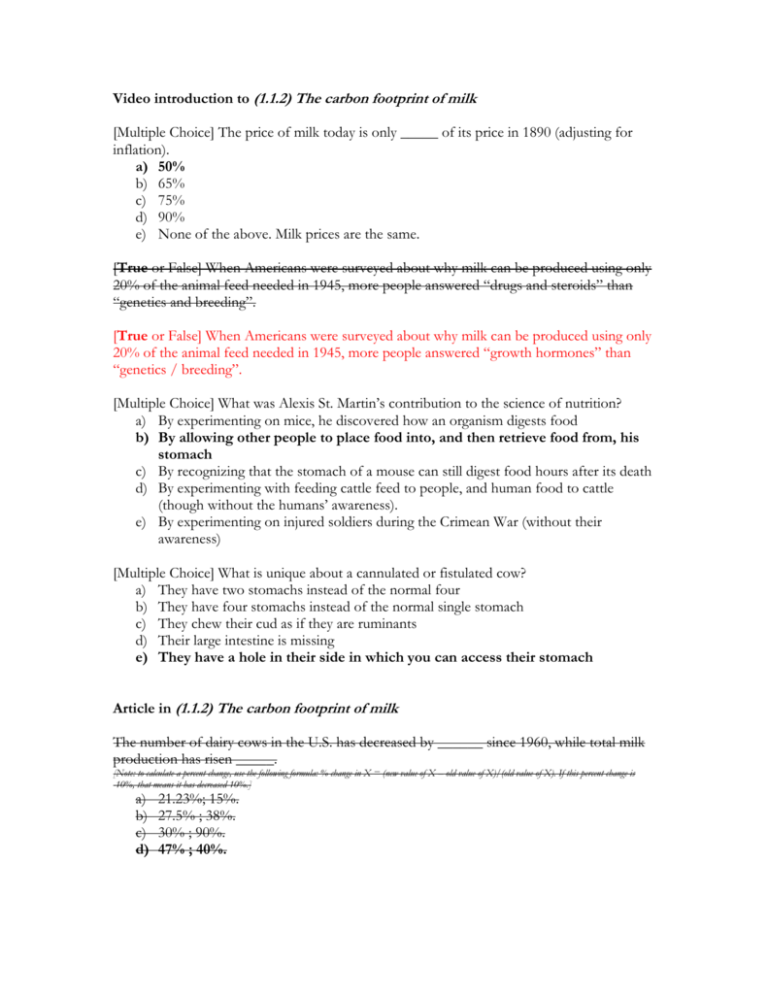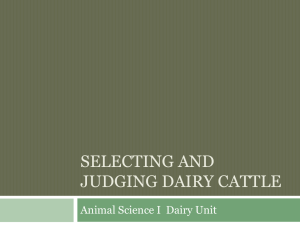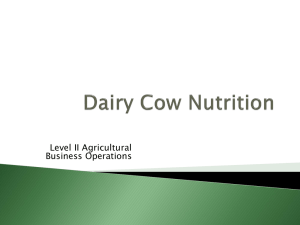Video introduction to (1.1.2) The carbon footprint of milk [Multiple
advertisement

Video introduction to (1.1.2) The carbon footprint of milk [Multiple Choice] The price of milk today is only _____ of its price in 1890 (adjusting for inflation). a) 50% b) 65% c) 75% d) 90% e) None of the above. Milk prices are the same. [True or False] When Americans were surveyed about why milk can be produced using only 20% of the animal feed needed in 1945, more people answered “drugs and steroids” than “genetics and breeding”. [True or False] When Americans were surveyed about why milk can be produced using only 20% of the animal feed needed in 1945, more people answered “growth hormones” than “genetics / breeding”. [Multiple Choice] What was Alexis St. Martin’s contribution to the science of nutrition? a) By experimenting on mice, he discovered how an organism digests food b) By allowing other people to place food into, and then retrieve food from, his stomach c) By recognizing that the stomach of a mouse can still digest food hours after its death d) By experimenting with feeding cattle feed to people, and human food to cattle (though without the humans’ awareness). e) By experimenting on injured soldiers during the Crimean War (without their awareness) [Multiple Choice] What is unique about a cannulated or fistulated cow? a) They have two stomachs instead of the normal four b) They have four stomachs instead of the normal single stomach c) They chew their cud as if they are ruminants d) Their large intestine is missing e) They have a hole in their side in which you can access their stomach Article in (1.1.2) The carbon footprint of milk The number of dairy cows in the U.S. has decreased by ______ since 1960, while total milk production has risen _____. [Note: to calculate a percent change, use the following formula: % change in X = (new value of X – old value of X)/(old value of X). If this percent change is -10%, that means it has decreased 10%.] a) b) c) d) 21.23%; 15%. 27.5% ; 38%. 30% ; 90%. 47% ; 40%. The number of dairy cows in the U.S. has decreased by ______ since 1960, while total milk production has risen _____. a) thousands; 15%. b) thousands; 38%. c) billions ; 90%. d) millions; 40%. In 1960 the average cow produced 755 gallons per year, while the average cow today produces ________ gallons per year. a) 1,745 b) 2,326 c) 1,045 d) 4,001 e) 4,325 To produce a gallon of milk today, dairy cows today need only _____ of the feed and ______ of the water they would have needed in 1945. a) 1/10 ; 1/8 b) 1/5 ; 1/3 c) 1/9 ; 1/15 d) 1/2 ; 1/2 e) 1/4 ; 1/2 The carbon footprint of a gallon of milk in 1945 was about ________ times higher than the footprint today. a) 2 b) 3 c) 4 d) 5 e) 6 Although more milk is produced in the U.S. today than in 1945, the total carbon footprint from all milk production is _______ of that in 1945. a) 2/3 b) 1/2 c) 1/3 d) 1/5 e) 1/10 Suppose that, over time, the carbon footprint from one gallon of milk is cut in half, but over that time period total milk production rose 70%. How would the total carbon emissions from all milk production change? a) It would rise b) It would fall c) It would remain the same Suppose that, over time, the carbon footprint from one gallon of milk is cut in half, but over that time period total milk production rose 100%. How would the total carbon emissions from all milk production change? a) It would rise b) It would fall c) It would remain the same Cows emit methane as they ______, and they do so about ______ every minute. a) Burp; once b) Burp; twice c) Burp; thrice d) Fart; once e) Fart; twice f) Fart; thrice The black and white cows you see in Chick-fil-A commercials are called ____________ cows and are the most popular breed due to their superior milk production. a) Holstein b) Jersey c) Angus d) Simmental e) Brahma Small, brown dairy cows are called ____________ cows, and have the advantage of converting feed to milk more efficiently and producing more ___________ in their milk. a) Holstein; butterfat b) Jersey; protein c) Holstein; protein d) Jersey; butterfat e) Angus; lactose The popular dairy breeds in the U.S. all originated from a) China and Korea b) Australia and New Zealand c) South America (including the Falkland Islands) d) Britain and Europe e) The oriental Steppes A farmer in the Elizabethan Age would predict a cow’s milk production by a) Whether it was a full moon when the cow was born b) The number of baptisms taking place in the local community when the cow was born c) Whether the cow had straight or curved horns d) The direction of its hairs on the rear part of her udder e) None of the above The twentieth century saw great improvements in nutrition science, such as cracking grain to make them more easily digestible by cattle. Another improvement is providing feed based on the cows’ _______ needs, not her _______ needs. a) Energy; carbohydrate b) Protein; carbohydrate c) Protein; energy d) Energy; protein e) Carbohydrate; protein A dairy cow’s diet is determined by the cow’s nutritional needs, the price of various feeds, and _______. a) Rules-of-thumbs about how the feed should be designed b) Recommendations based on the farmers’ almanac c) Computer algorithms d) None of the above







